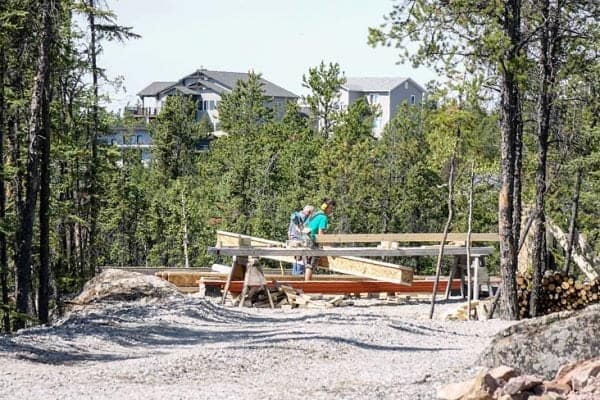A housing market report from the Canada Mortgage and Housing Corporation (CMHC) shows approximately 2,500 Yellowknifers cannot affordably secure any market housing option.

A home under construction Wednesday in the Grace Lake South subdivision.
Almost 30 per cent of residents had unaffordable housing in 2015, without the rent subsidy offered by the NWT Housing Corporation.
From 2014 to 2015, “affordability issues continued to rise across the territory,” states the report.
However, those numbers play out differently for residents who have core housing challenges – meaning they pay more than a third of their income towards rent, and live in overcrowded or poor conditions in their dwelling.
The number of residents in Yellowknife with core housing need increased from 10.1 per cent in 2011 to 10.7 per cent in 2016.
In light of affordability challenges, the Northwest Territories Housing Corporation extended its rental subsidy program in 2017, said Tom Williams, president of the NWT Housing Corporation in an interview.
Under the program, earners making less than $70,000 and spending more than 30 per cent of their income on rent are subsidized up to $500 per month.
The city also implemented its Housing First plan to tackle homelessness in the city by providing rental units and social services in a pilot project.
There has been a reduction in core need in areas outside of Yellowknife, said Williams.
“It seems to be more positive in certain areas. Any time you see a reduction in core need, its positive. As a supplier of social housing we're doing our part,” he said.
Cutting down on core housing need will require more investment and program delivery, said Williams.
Any progress on core housing need is a “relief,” he said.
Enhancing programs including rapid rehousing will alleviate issues of housing stability, he said.
Those programs, which have been extended, address homelessness by providing housing supports for at risk individuals who might be in arrears or homeless by way of being unable to afford a rental deposit.
“As we have more programs available to individuals it's certainly going to help,” he said.
Comparably, Whitehorse has a higher core need (12 per cent) but overall lower average rents at an average of $1,063 for a two bedroom apartment.
In Yellowknife, there is a higher cost of delivery to bring housing into the market.
“I'd say we're in the mid range compared to Iqaluit and Whitehorse,” said William.
For now, Yellowknife's rental market is dictated by supply and demand. There have never been legislated rent controls, he said.
Vacancy rates went down slightly in 2017, likely because of demand from workers at Gahcho Kue mine, the report states. The uptick in demand from mining projects gave landlords room to raise rents by 1.6 per cent in 2017.
The CMHC predicts vacancy rates will stay relatively stable into 2018 and that mining projects will maintain demand.
Buying housing in Yellowknife was slightly more costly, three per cent exactly, because of higher priced units and in 2017, there were half as many homes built compared to 2016.
The report attributes slow construction growth to land availability for single-detached homes. However, there is a strengthening market interest in condominium units.
The numbers in the CMHC report don't amount to an affordability crisis for most Yellowknife households, said Williams.
Yellowknife has a “mature housing market with a good mix of ownership,” he said.
The rental assistance subsidy cuts off at $70,000. Any income earners beyond that bracket are, by the CMHC's standards, able to affordable secure housing in Yellowknife's rental market or purchase a condo.
The report shows the territory's GDP has increased 5.1 per cent, but employment in the public sector declined as the GNWT reduced its workforce by 1,200 between 2016 to 2017.
Despite a shrinking labour force, Yellowknife is a high-income jurisdiction, said Williams.
The CMHC report states that income earners raking in $100,000 are able to afford any option, including purchasing a single-detached home.
“We've seen in the last while, many people have left the rental market in favour of home ownership rather than renting,” he said.
Encouraging local home ownership is just one way to relieve market pressures and the NWT Housing Corporation is working to roll out two new programs to encourage home ownership, said William.